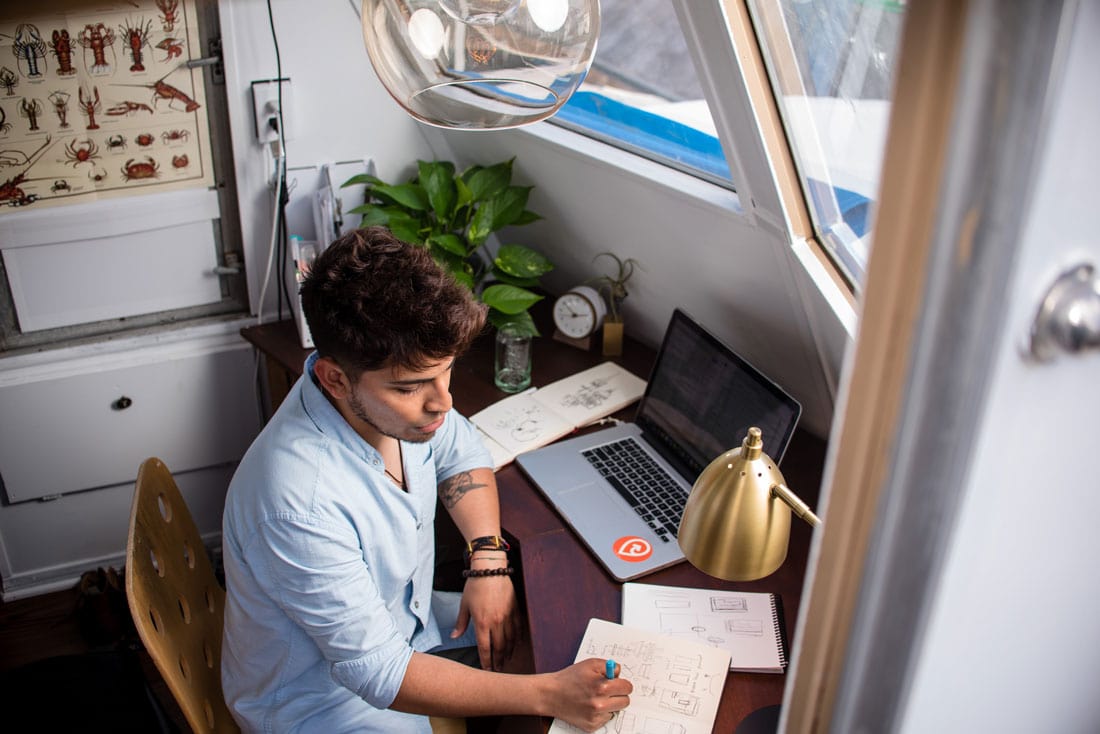Do you have dreams of ditching your day job and becoming a full-time freelance graphic designer? Start putting your plan in motion.
Most freelancers start with graphic design as a side hustle, but with determination, business planning, and a solid work ethic, you can build as much business as you want to create a sustainable career.
Here are 10 steps to help you get started.
Trust me, I’ve tested them all in my decade as a freelancer!
Step 1: Start Building a Portfolio
A strong portfolio is a must if you plan to bring in clients on your own.
While it can be tempting to dump everything you’ve done recently into a portfolio, be selective. Only include projects and examples that are stellar examples of the kind of freelance work you want to do. (If you plan to focus on print, don’t pack your portfolio with digital projects.)
Use your portfolio as a showpiece to sell your work to potential clients. You’ll quickly find that the type of work you showcase often results in similar inquiries for future projects.
Step 2: Create a Brand
Start building a brand for yourself early.
Buy a domain, create an email address, and establish an online presence as a graphic designer. While you are doing this brand work, consider whether you plan to do freelance work under your name or create a business name. (You might want to do the footwork for both if you are on the fence.)
There are pros and cons to both options – using your name or creating another company name – making it a personal choice of how you want to do business as a freelance graphic designer.
Step 3: Establish Yourself as an Authority
Part of building your brand is to establish yourself as an authority in all things design, with a specific focus on the type of freelance work you want to bring in.
Write guest blog posts on design topics, use social media to highlight work of interest (yours and that of others), and make connections in the industry. Enter contests and engage in professional networks to expand your circle and show off your expertise to others.
Step 4: Network
Put yourself out there. Even if you have a job and are just toying with the idea of going freelance, you need to grow your professional networks. (You will generate a ton of business from these strong connections.)
Think about who your target clients are and network with professionals who work with those clients now. That might include joining local networking groups or professional organizations or spending some time networking at design conferences.
Find a champion or mentor in this space that’s already doing it in the way you envision for yourself. (And when you are in a position to mentor someone else, make sure to jump on the opportunity to give back.)
Step 5: Create a Business Plan and Goals
So much of becoming a freelance graphic designer isn’t creative at all. It’s laying a solid business foundation to facilitate future success.
If you plan to use freelance work as merely a side gig, a full business plan might not be necessary. But you still need to think about time, taxes, and the balance of revenue and expenses. (The goal is to make money, right?)
If you plan to enter into freelancing as a full-time job, you need a business plan and goals. How much income do you need to make it work? What about costs from healthcare to taxes to software and computers and marketing? What services and contractors do you need (legal, CPA, licenses, and insurance)?
Create measurable goals to help you figure out if your plan is working. And have a fallback plan if the freelance lifestyle ends up not being for you.
Step 6: Start Taking Clients
Start taking freelance clients.
While you are probably ready to jump in, it’s a good idea to start small. The first few clients and projects might take more time or work that you anticipate. From meetings to revisions to figuring out what exactly a client needs, you want to give yourself plenty of time to be successful (and not burn out right away).
Over time, you’ll get an idea of what client time looks like, how long certain projects take, and where you can focus on making the most money and getting creative fulfillment.
Step 7: Diversify Work and Clients
Don’t spend all your freelance time working for one client or on just one type of project. You never know when that business might dry up.
It’s a good idea to create a diverse client base. An ideal mix includes a few regular clients with predictable needs, a couple of big projects that you can complete and move on, and a few new clients or projects. If you can figure out a way to generate some regular income from tools (such as UI kits or reselling hosting to website clients) that’s always a bonus as well.
Step 8: Create a Referral Network
There will come a time that every freelancer is maxed out. You just can’t take another project because you are busy or need a little time off. And that’s OK.
Refer clients to other graphic designers that you trust. Creating a referral network that you can send clients to establishes your reputation and can work reciprocally when other freelancers refer clients back to you. Only send clients to other designers that you trust.
Have a conversation with designers that you might send clients to. These might be others that you work with regularly (or even contract work with) or designers from your extended network. Make sure they know you may send work their way. (It’s good for business in the long run.)
Step 9: Evaluate and Specialize (If Necessary)
While it is good to have a mix of clients and projects, some freelancers can benefit from specialization. Do you do something that there’s a strong demand for and not a lot of people to meet it? Specialization might be the key.
If you want to specialize in a specific area, do your homework. Is there enough work to support your business? Can you work efficiently in this area? Will you be satisfied with one line of design work?
Don’t box yourself in. Just because you decide to specialize in something, it doesn’t mean you can’t take other projects. It also doesn’t mean that you can’t change over time.
Market and client needs change. Stay on top of your business and the industry. Evaluate your projects and clients periodically to make sure you are doing what’s best for your career.
Step 10: Pay Yourself a Salary
Now for the fun part – make sure to pay yourself!
Separate business and household money. Use different accounts, credit cards, and keep track of everything. Operate the freelance work as a business to make everything more manageable in the long run. (Believe me, your CPA will thank you.)
Then from the business, pay yourself a salary. (Hopefully, you’re are doing enough business to pay yourself well.) Don’t pay household bills from your business accounts. Keeping the business and personal accounts separate will make for easier, and less stressful accounting over time.
Conclusion
You can be a freelance graphic designer. It’s more than a dream, and in a growing gig economy worldwide, you can find a place in the creative industry on your own.
You will have to work at it. But if freelance graphic design is something you are interested in, you can use this plan to get started.
from Design Shack https://designshack.net/articles/business-articles/how-to-be-a-freelance-graphic-designer/
The following blog article How to Be a Freelance Graphic Designer in 2019: A 10 Step Plan was initially published to https://www.instant-web-site-tools/
source https://www.instant-web-site-tools.com/2019/07/03/how-to-be-a-freelance-graphic-designer-in-2019-a-10-step-plan/





No comments:
Post a Comment